WASHINGTON -- The Supreme Court on Monday handed the Environmental Protection Agency a victory in its efforts to regulate greenhouse gas emissions from stationary sources such as power plants, even as it criticized what it called the agency's overreaching.
"EPA is getting almost everything it wanted in this case," Justice Antonin Scalia said in summarizing the decision from the bench. "It sought to regulate sources it said were responsible for 86 percent of all the greenhouse gases emitted from stationary sources nationwide. Under our holdings, EPA will be able to regulate sources responsible for 83 percent of those emissions."
Scalia said the agency was free to do so as long as the sources in question "would need permits based on their emissions of more conventional pollutants."
That part of the decision, which effectively sustained regulation of nearly all the sources the agency had sought to regulate, was decided by a 7-2 vote. Chief Justice John Roberts Jr. and Justices Anthony Kennedy, Ruth Bader Ginsburg, Stephen Breyer, Sonia Sotomayor and Elena Kagan joined that part of the decision.
The agency expressed satisfaction with the ruling.
"The Supreme Court's decision is a win for our efforts to reduce carbon pollution because it allows EPA, states and other permitting authorities to continue to require carbon pollution limits in permits for the largest pollution sources," the agency said in a statement.
American Petroleum Institute general counsel Harry Ng praised the decision as "a stark reminder that the EPA's power is not unlimited," while Missouri Republican Sen. Roy Blunt said "the Supreme Court's move to limit the EPA's overreach is a step in the right direction."
Another part of the decision limited, but didn't eliminate, the EPA's power to regulate certain greenhouse gas emissions.
In a 5-4 decision, the court declared that the EPA can't require stationary polluters to get permits solely because they might emit greenhouse gases. This would cover too many small greenhouse gas sources such as schools and churches, the majority reasoned.
"We think it beyond reasonable debate that requiring permits for sources based solely on their emissions of greenhouse gases ... would be incompatible with the substance of Congress' regulatory scheme," Scalia wrote for the majority.
"An agency has no power to 'tailor' legislation to bureaucratic policy goals by rewriting unambiguous statutory terms," Scalia wrote. Roberts, Kennedy and Justices Clarence Thomas and Samuel Alito Jr. joined that part of the decision.
The National Federation of Independent Business welcomed what it said was the Supreme Court's refusal to allow the agency to rewrite the statute.
"If this rule had been allowed to stand, small-business owners such as ranchers, farmers, manufacturers, restaurant owners and others would have seen more paperwork, more oversight and fines," the group said in a statement.
"The Supreme Court largely upheld EPA's approach to focusing Clean Air Act permits on only the largest stationary sources of greenhouse gases such as power plants, refineries and other types of industrial facilities," Liz Purchia, an EPA spokesman, said in a statement.
The heart of the decision focused on requirements in the Clean Air Act that facilities get a review if they emit any air pollutant at 100 tons or 250 tons, depending on the type of source. While that is a large amount for traditional pollutants such as mercury or sulfur dioxide, it could cover many more facilities if carbon dioxide emissions were counted at that level.
Applying the law as written would increase the number of covered sources under one program to more than 80,000, from fewer than 280, reaching commercial and residential sources and subjecting them to expenses averaging almost $60,000, according to a decision under review, from the U.S. Court of Appeals for the District of Columbia Circuit.
A second program would reach 6 million sources, subjecting them to expenses of more than $20,000 each. The cost of the programs would rise to $21 billion from $62 million.
Before Monday's decision, the EPA had instituted a provision to alter the applicability of the permits to larger facilities as a way to get around the tonnage requirement. That system was tossed by the court Monday.
The regulations challenged in Monday's decision built on the Supreme Court's 5-4 decision in 2007 in Massachusetts v. Environmental Protection Agency, which required the agency to regulate emissions of greenhouse gases from new motor vehicles if it found that they endangered public health or welfare.
The agency made such a finding, saying that "elevated concentrations of greenhouse gases in the atmosphere" pose a danger to "current and future generations," and it set limits on emissions from new vehicles.
The agency said its regulation of tailpipe emissions also required regulation of emissions from stationary sources under two permitting programs. While acknowledging that the relevant provisions of the Clean Air Act fit such emissions imperfectly, the agency said the law nonetheless compelled it to require permits.
The case decided Monday was Utility Air Regulatory Group v. Environmental Protection Agency, No. 12-1146.
Information for this article was contributed by Adam Liptak of The New York Times; by Michael Doyle of the McClatchy Washington Bureau; and by Greg Stohr and Mark Drajem of Bloomberg News.
A Section on 06/24/2014


